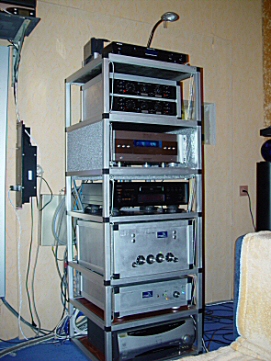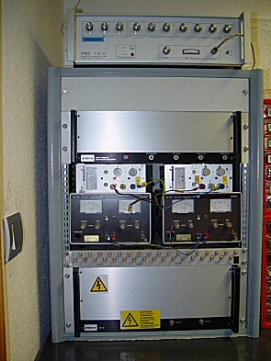Stephan Goëtze, Germany

The System:
1. The idea coming to that system: In 2004/2005 I heard some very good systems ( Kharma, Avalon) using the new Thiel ceramic chassis. I liked the reproduction very much, but missed dynamics. So the idea came up to build a horn- system around them. The bass should give no problem, cause there I could use the Oris horns with the BD15 chassis. I wanted the ability to adjust phase for optimal conditions at my listening position, so I build a structure made by Rexroth alloy profiles. So the single drivers can be adjusted very accurate, using measurement equipment and of course listening tests. All empty spaces are filled with sand, to avoid resonance. The cabinets for bass and midrange are outside rectangular forms, but the volume inside is more or less “drop-shaped” and a matrix. The outside of the bass cabinet is covered with alloy foam, to avoid reflections and resonances. The midrange horn is made of ceramics. The tweeter-horn is made of reinforced resin. All surfaces are covered with acoustic foam to avoid also reflections. The speakers are a bit heavy, about 380 kg a piece…
2. The sofa is basically a big subwoofer with a volume of 200 l. Inside there is a 38 cm Focal woofer. This subwoofer is controlled by a Volodyne SMS-1. Basically not to extend the bass, cause the Oris System goes pretty low, but to correct for room modes. Maybe it looks like a sofa, but the base plate is concrete and also a lot of sand used for damping. Also a bit on the heavy side with 470 kg…


3. The power amps are a new SET construction, getting some new ideas working: The first step is a decent power supply. All necessary voltages have there own separate transformers and except the plate voltage for the GM-70 output tube, all voltages are regulated. I used ample of capacity for the power supplies: there are 5000µF/ 450 V for anode voltage of the drivers, 150000µF/35V for the driver heaters, 80000µF/63 V for the GM-70 heater, 5000µF /350V for the bias and 33000µF/500V for the plate voltage of the output tube. Of course a good measure of coils and film capacitors also. That power supplies start up, controlled by a sequencer, to avoid tube wear and to run at controlled conditions all the time. A lot of security is also build in…All the power supplies are mounted on low resonance boards. The complete audio circuit is mounted on a spring loaded sub chassis, tuned to 2 Hz . Also the tubes are not visible to avoid acoustic or rf interference. They are cooled by ultra low noise fans, which can´t be heard in one meter distance ( 17 dBa). The housing is made of a special alloy sandwich, giving excellent rf-shielding and being acoustically very good, for having no resonance-frequency. The output transformers are custom made toroidal transformers , weighting about 20 kg. The results, as well for measurements as for sonics are very good. It´s no typical “ tube sound” – there are the advantages of tube gear, but extremely fast, clear and dynamic reproduction…
4. The bass amps are solid state designs, having enough power and also being very fast. I would rate them as a good standard design with over sized power supplies.
5. Source is a heavily modified Musical Fidelity Tri Vista SACD/CD-player. Especially the master-clock is a nice design, being coupled to the in house caesium standards.
6. D/A converter is based on a hoerwege DAC-UP 1794 with an own ultra stable battery power supply.
7. For video there is a Denon DVD-1 and a Kenwood AV-receiver ( soon to be replaced)
8. The Main preamp is an own construction, incorporating also some new ideas. I´m going to put a patent on that, so I can not speak about details.
9. The rack is an own construction with very good decoupling abilities, especially for the SACD/CD player, where I use a magnetic suspended platform of alloy foam.
10. Cables for the midrange/tweeter section are Nordost Reference SPM, for the bass a 4 x 4mm² shielded configuration. Other interconnects are mostly DIY of pure silver, the long interconnect between preamp and the SET amps is an active shield design.

11. I spent a lot of effort on the line power and grounding: Preamp and sources are run from an AC power source, powered by batteries ( 280 AH at 24 V), than I´ve matched line filters to every single component. The power amps use isolation transformers and also matched filters. By that concept a lot of garbage, being on the line is eliminated. Also all casings of the units are connected to the “normal” earth, but the audio ground is everywhere galvanically separated and run on a separate earth ( an anchor in the garden).
12. The room is acoustically treated: Rear wall 10 cm thick cover of acoustic foam, ceiling 2 cm of acoustic foam. The bookshelves are damped and treated to give no resonance. The books themselves are arranged for diffraction of sound. The room is quite neutral and nothing can rattle!
Building most of the gear myself was real fun and also much more economical than simply buying gear. The results of a tailored system like that are simply better than that of most systems bought from commercial made components.
The next project will be to build a turntable.
I´m open to discussions and sharing of experience, so contact me at: technik@gecom-technologies.com